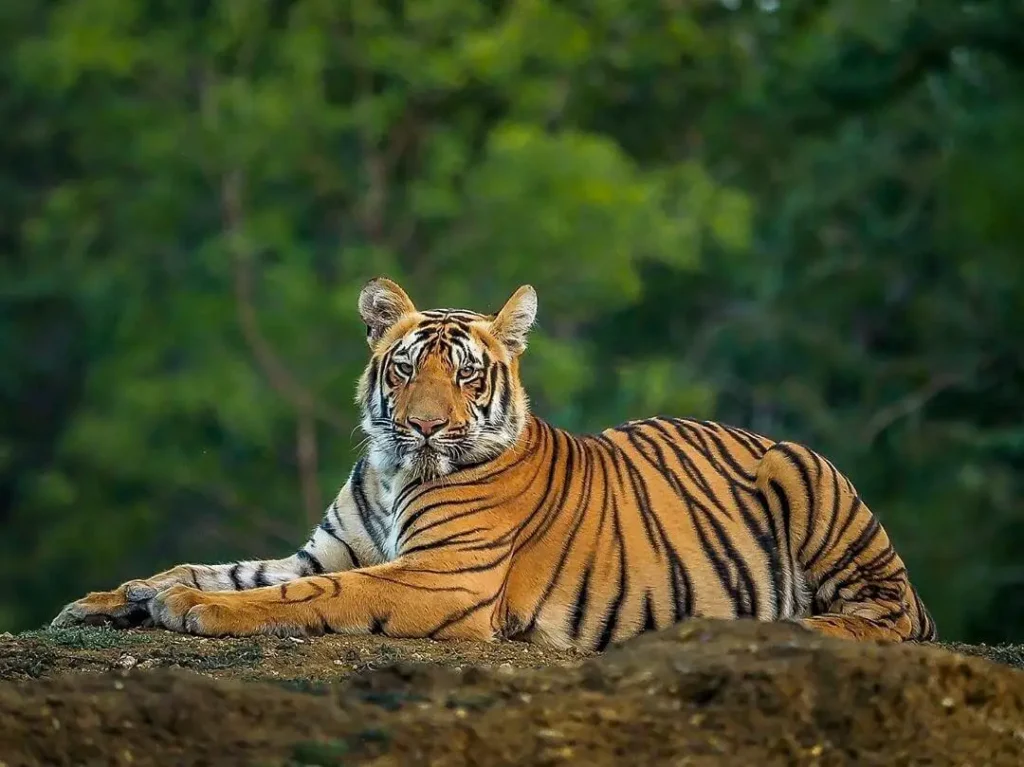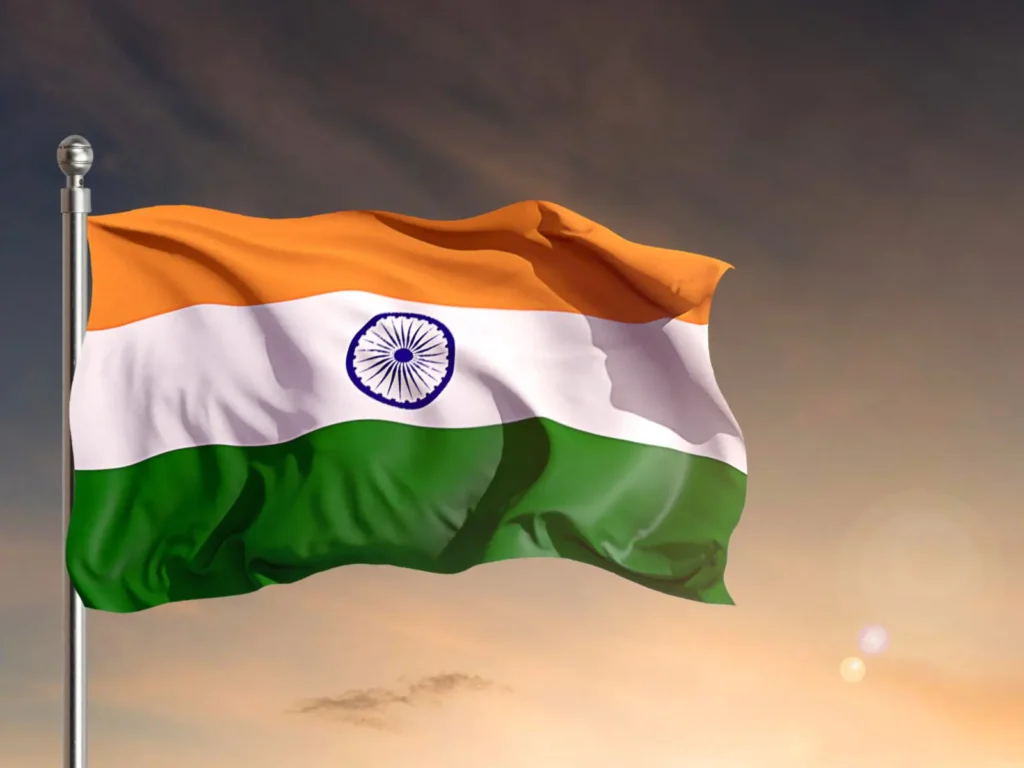India Essay for Students and Children
Essay on India: India is a great country where people speak many different languages, but the national language is Hindi. India is full of people from different castes, creeds, religions, and cultures, but they all live together. In this essay on India we will talk about India’s culture, geography, national symbols, flag of india, and some favourite state. You can also find more Essay Writing articles about events, people, sports, technology, and many other things.

India is the second most populous country in the world and the seventh largest country by land area. It is in Asia. India became free on August 15, 1947. India now has 29 states and 7 union territories, and it shares land with Nepal, Afghanistan, Bhutan, Bangladesh, Pakistan, China, and Myanmar.
The Indian flag is horizontal and has three colours: a deep saffron colour at the top, a white colour in the middle, and a dark green colour at the bottom. In the middle of the white colour is an Asoka Chakra.
The Indian national animal is the Royal Bengal Tiger. The Indian national bird is the Peacock. The Indian national fruit is the Mango. The Indian national flower is the Lotus. Rabindranath Tagore wrote India’s national anthem, “Jana Gana Mana.” Their national song is “Vande Mataram,” and their national sport is hockey.

Essay on India in English
People in India speak many different languages, but Hindi is the national language. India is full of people from different castes, creeds, religions, and cultures, but they all live together. This is why the phrase “unity in diversity” is often used to describe India. India is the seventh largest country in the world.
Geography and Culture of India
India is home to the second most people on Earth. India is also sometimes called Bharat, Hindustan, and Aryavart. It is surrounded by the Bay of Bengal to the east, the Arabian Sea to the west, and the Indian Ocean to the south. The Indian national animal is the tiger. The peacock is the Indian national bird. India’s favourite fruit is the mango. The national song of India is called “Jana Gana Mana.”
The Indian national song is “Vande Mataram.” The Indian national sport is hockey. People of Hinduism, Buddhism, Jainism, Sikhism, Islam, Christianity, and Judaism have lived together for thousands of years. India also has a lot of monuments, tombs, churches, historical buildings, temples, museums, places of architecture, places with beautiful scenery, wildlife sanctuaries, and more. India is home to many great leaders and people who fought for freedom.
The Indian flag

The flag of India has three colours.
- Saffron
- White
- Green
The first colour in the flag, which is saffron and is at the top, stands for purity. The second colour on the flag, or the middle colour, is white, which stands for peace. The green colour, which is the third and lowest colour in the flag, means fertility. On the white colour, there is a blue Ashoka Chakra. Ashoka Chakra has twenty-four spokes that are all about the same size. There are 29 states and seven union territories in India.
Physical Features of India
The Indian subcontinent has many physical features in common with its neighbours, Pakistan, Nepal, Bhutan, and Bangladesh, which are also in the subcontinent. India’s natural regions are made up of six different types of land.
- The Northern Mountains
- The Northern Plains
- The Great Indian Desert
- The Southern Plateau
- Coastal Plains
- The Island Regions
The Himalayas, which are in the Northern Mountains, are the highest mountains in the world. They naturally separate India from a large part of Asia. In these mountains are the countries of Nepal and Bhutan, which are next to each other.
The Northern Plains are to the south of the Himalayas. In the west, they go into Pakistan. Bangladesh is in the part of the plains to the east.
The Great Indian Desert: There is less rain in the western part of India, which is a desert. The Thar Desert is the name of this desert.
The Southern Plateau: This plateau area, called the Deccan Plateau, is south of the Great Northern Plains. The Deccan Plateau is surrounded by the Vindhya and Satpura ranges in the north, the Western Ghats, and the Eastern Ghats.
The Coastal Plains: Between the Bay of Bengal and the Eastern Ghats is the Eastern Coastal Plain. Between the Arabian Sea and the Western Ghats is the western coastal plain.
The two archipelagos that make up India’s island regions are on either side of the peninsula. The Andaman and Nicobar Islands are in the Bay of Bengal, while the Lakshadweep Islands are in the Arabian Sea.
National Symbols Of India
- The Indian flag is a tricolour with equal amounts of deep saffron on top, white in the middle, and dark green at the bottom. The saffron represents courage, sacrifice, and the willingness to let go. The white represents purity and the truth, and the green represents faith and fertility. In the Sarnath Lion Capital, there is a wheel of law in the middle of the white band.
- The National Emblem of India is a copy of the Lion of Sarnath. It shows that India is still committed to world peace and goodwill as it has been for a long time.
- India’s national anthem is called “Jana Gana Mana,” and the country’s national song is called “Vande Mataram.”
- The Tiger is India’s national animal, and it is a symbol of grace, strength, and power.
- India’s national bird is the peacock, which is a sign of beauty, pride, and power.
- India’s national flower is the lotus, which stands for cleanliness, wealth, richness, knowledge, and peace.
- India’s national tree is the Great Banyan Tree, which is thought to be sacred and immortal because of how it looks and how long it lives. It is a big part of the Indian myths and legends.
- Mango is the country’s national fruit, and it is the most widely grown fruit in the tropical world.
Food
The food in India is varied. The way a place is set up affects what people eat there. What grows in a place is what people eat most of the time. Wheat is the most important food in North India. Rice is the main food in East and South India. Millet is the most important food in West India. Nearly the whole country eats daals, which are made in different ways.
Languages
There are many languages spoken by Indians. There are 22 languages mentioned in the Constitution of India. India, on the other hand, has about 1000+ languages. India uses Hindi as its official language.
The following are my favourite Indian states:
Rajasthan
Rajasthan has its own great history. It is known for its many brave kings, the things they did, and the art and buildings they made. The nuclear test was done here because it has a sandy track. Rajasthan has a desert, a mountain range, lakes, dense forests, beautiful oases, temples, and a lot more. “Land of Sacrifice” is another name for Rajasthan. In Rajasthan, you can visit Udaipur, Jodhpur, Jaisalmer, Chittaurgarh, etc. to see things left behind by the kings who ruled there.
Jammu and Kashmir
People call Jammu and Kashmir “heaven on earth.” Jammu and Kashmir is also a great place for tourists to visit. Jammu and Kashmir has many places to visit because they have a natural landscape, roads that cars can drive on, beauty, harmony, romance, scenery, temples, and more.
Kerela
Kerala is a state in India that is known as “God’s Own Country.” It is in the southwest of the country and is surrounded by beaches. The Western Ghats hills and backwaters make it a popular tourist destination because of its natural beauty. The museum, sanctuary, temples, backwaters, and beaches are the most important places to visit in Kerala. Munnar, Kovalam, Kumarakom, and Alappad.
Conclusion
India is a great place where people from different cultures, castes, creeds, and religions live together. India is well known for its history, its spices, and, of course, its people. This is why the phrase “unity in diversity” is often used to describe India. India is also known as a place where spirituality, philosophy, science, and technology all come together.

